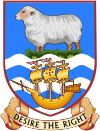Governor of the Falkland Islands
| Governor of the Falkland Islands | |
|---|---|

Coat of Arms of the Falkland Islands
|
|
| Viceroy | |
| Style | His Excellency |
| Residence | Government House, Falkland Islands |
| Appointer | Monarch of the United Kingdom |
| Term length | At His/Her Majesty's pleasure |
| Formation | 1764 |
| First holder |
Louis Antoine de Bougainville as Administrator of the French Settlement |
| Website | Office of the Governor |
The Governor of the Falkland Islands is the representative of the British Crown in the Falkland Islands, acting "in Her Majesty's name and on Her Majesty's behalf" as the islands' de facto head of state in the absence of the British monarch. The role and powers of the Governor are set out in Chapter II of the Falkland Islands Constitution. The Governor in office resides at Government House, which serves as the official residence.
The history of the leadership on the islands is closely related to the history of the Falkland Islands themselves. The first settlement on the islands was at Port St. Louis and was led by Louis Antoine de Bougainville, the Administrator of the French settlement which started in 1764 and ended three years later. The first leader of a British settlement was John McBride, Captain of HMS Jason, in 1766 at Port Egmont (the settlement being established a year earlier). The French settlement of Port St. Louis was transferred to the Spanish in 1767 and renamed Puerto Soledad, the first Spanish Military Administrator being Felipe Ruíz Puente. The British chose to withdraw from many overseas settlements in 1776 due to the pressure of the American War of Independence. The Spanish settlement ended in 1811 as a result of the Peninsular war.
In 1829 Luis Vernet was proclaimed Military and Civil Commander of Puerto Luis (the Falklands) by the United Provinces of South America, which elicited a protest from the British Government. In 1831, Vernet seized three US vessels and imprisoned their crews for contravening his regulations on sealing, prompting a raid by the USS Lexington. In response, the United Kingdom sent a task force to reassert British sovereignty over the Falkland Islands in 1833. The Falklands were then settled, mainly by people from Wales and Scotland.
...
Wikipedia

